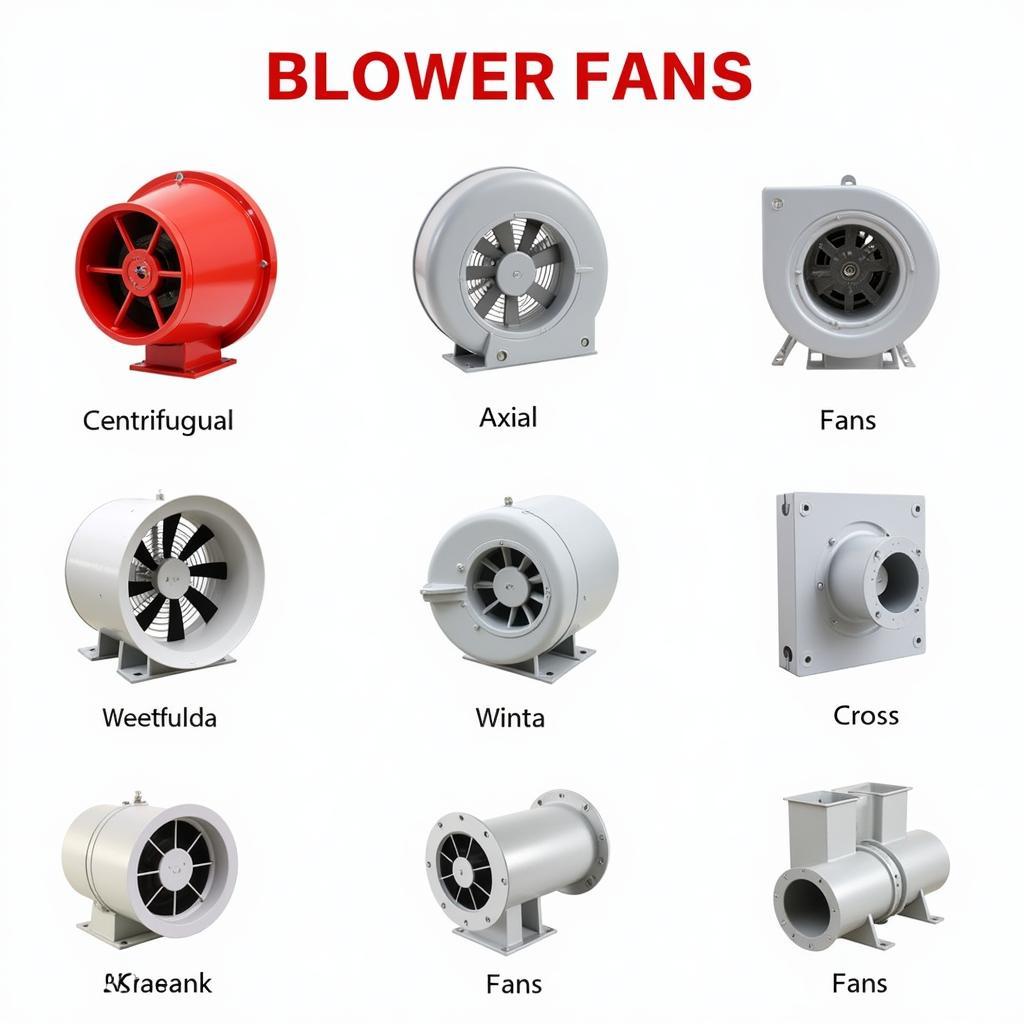Blower Fan Specifications are crucial when choosing the right fan for your application. Whether you’re dealing with HVAC systems, industrial processes, or electronics cooling, understanding these specifications ensures optimal performance, efficiency, and longevity. This comprehensive guide delves into the essential blower fan specifications and their significance.
Understanding Blower Fan Specifications
Blower fan specifications provide a detailed technical description of the fan’s capabilities and limitations. These specifications are essential for engineers, technicians, and consumers to make informed decisions when selecting and installing blower fans.
 Types of Blower Fans
Types of Blower Fans
Key Blower Fan Specifications
Airflow Rate (CFM or m3/h)
Airflow rate, measured in cubic feet per minute (CFM) or cubic meters per hour (m3/h), indicates the volume of air a fan can move within a specific time. Higher CFM values signify a greater volume of air moved, crucial for applications requiring significant ventilation or cooling.
Static Pressure (Inches of Water Gauge or Pascals)
Static pressure measures the resistance the fan overcomes to move air. It’s usually represented in inches of water gauge (in. wg) or Pascals (Pa). A higher static pressure rating indicates the fan can effectively move air against greater resistance, such as in ductwork systems.
Power Consumption (Watts or Horsepower)
Power consumption, measured in watts (W) or horsepower (HP), represents the energy required to operate the fan. Choosing an energy-efficient fan with lower power consumption can lead to significant cost savings in the long run.
Speed (RPM)
Fan speed, measured in revolutions per minute (RPM), directly impacts the airflow rate. Higher RPM generally results in higher airflow. However, it also affects noise levels and energy consumption, necessitating a balance based on specific requirements.
Noise Level (Decibels)
Noise level, measured in decibels (dB), is a crucial factor, especially in noise-sensitive environments. Manufacturers provide noise ratings to indicate the sound levels produced by the fan during operation.
Fan Size and Dimensions
Physical dimensions, including fan diameter, housing size, and mounting options, are essential considerations for ensuring compatibility with the intended application and available space.
Operating Temperature
The operating temperature range specifies the safe temperature limits within which the fan can function effectively without compromising performance or experiencing damage.
Matching Blower Fan Specifications to Your Needs
Selecting the right blower fan involves carefully considering your specific application requirements:
HVAC Systems: For residential and commercial HVAC systems, airflow rate, static pressure, and energy efficiency are critical factors.
Industrial Applications: Industrial processes often demand fans with high airflow rates, robust construction, and the ability to handle high temperatures and dust.
Electronics Cooling: Cooling electronic components require fans with specific airflow characteristics, low noise levels, and compact designs.
Expert Insights
“Understanding blower fan specifications empowers you to make informed decisions,” says John Miller, a senior HVAC engineer at ABC Engineering. “By aligning these specifications with your application’s needs, you ensure optimal performance, energy efficiency, and system longevity.”
Conclusion
Blower fan specifications are the key to selecting the right fan for your needs. By understanding these specifications and carefully considering your application requirements, you can make informed decisions that lead to optimal performance, efficiency, and longevity. Always consult with a qualified professional for assistance with selecting and installing blower fans.
FAQs
Q1: What is the difference between CFM and m3/h?
A: Both measure airflow rate. CFM stands for cubic feet per minute, commonly used in the US, while m3/h represents cubic meters per hour, prevalent in other regions.
Q2: How do I determine the required static pressure for my application?
A: Calculating static pressure involves considering factors like ductwork length, bends, and filters. Consulting an HVAC professional is recommended for accurate assessments.
Q3: What is the impact of fan speed on performance?
A: Higher fan speed generally leads to higher airflow but also increases noise levels and energy consumption.
Q4: How important is energy efficiency in blower fans?
A: Energy-efficient fans consume less power, resulting in lower operating costs over the fan’s lifespan.
Q5: Where can I find blower fan specifications?
A: Manufacturers typically provide detailed specifications in product datasheets, manuals, or on their websites.
Common Blower Fan Specification Issues
Insufficient Airflow: If the fan doesn’t deliver the required airflow, it could be due to incorrect specifications, ductwork restrictions, or a malfunctioning fan.
Excessive Noise: High noise levels can indicate problems like unbalanced fan blades, improper installation, or choosing a fan with a noise rating exceeding acceptable limits.
Premature Fan Failure: Factors like operating the fan beyond its temperature limits, voltage fluctuations, or poor maintenance can lead to premature failure.
Need More Information?
Explore our website for further insights into female bowser fan art and other related topics.
Contact Us
For expert guidance and support in selecting the ideal blower fan for your needs, reach out to us at:
Phone Number: 0903426737
Email: fansbongda@gmail.com
Address: To 9, Khu 6, Phuong Gieng Day, Thanh Pho Ha Long, Gieng Day, Ha Long, Quang Ninh, Vietnam.
Our dedicated customer support team is available 24/7 to assist you.


